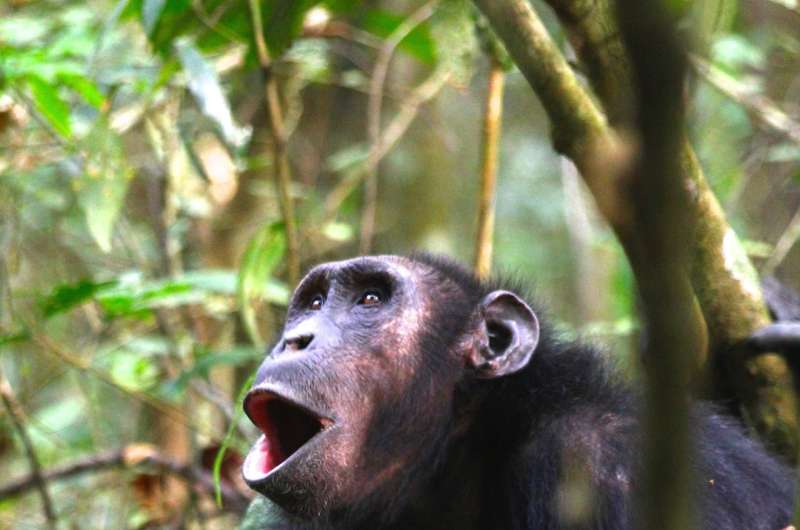Chimpanzees have at least three acoustically different 'hoo' call variants, each given in a different behavioural context. Credit: Liran Samuni
An important question in the evolution of language is what caused animal calls to diversify and to encode different information. A team of scientists led by Catherine Crockford of the Max Planck Institute for Evolutionary Anthropology found that chimpanzees use the quiet 'hoo' call in three different behavioural contexts—alert, travel and rest. The need to stay together in low visibility habitat may have facilitated the evolution of call subtypes.
Studies examining animal alarm calls suggest species which require different escape responses for different predators are more likely to have correspondingly different alarm calls, facilitating appropriate escape responses from receivers. However, what causes calls to diversify in less urgent contexts is little examined. "To address this, we examine a quiet contact vocalisation of chimpanzees, the 'hoo'", says Catherine Crockford of the Max Planck Institute for Evolutionary Anthropology. "We found that chimpanzees have at least three acoustically different 'hoo' variants, each given in a different behavioural context: alert, travel and rest."
In order to maintain cohesion, chimpanzee receivers must respond differently to signallers in each context: in rest contexts, receivers must stay in the vicinity of signallers, in travel contexts, receivers must approach signallers, and in alert contexts, receivers must approach signallers slowly. "Chimpanzees benefit from cooperating with bond partners, and are thus particularly likely to gain from staying close to cooperation partners", says Crockford. "However, chimpanzees live in low visibility habitat, such that even when separated by short distances visual signals or non-specific vocal signals are likely to be unreliable in maintaining cohesion. Thus, encoding contextual information in quiet 'hoos' may facilitate cohesion—and therefore cooperation."
One particularly interesting feature of the hoos is the low emotional arousal associated with their production, and that acoustic properties of the three hoo variants cannot be easily explained by emotional state, although this is a common explanation for call diversification in non-human animals. The need to stay together in low visibility habitat may have facilitated the evolution of different calls, with each call informing receivers how to behave in order for signaller and receiver to stay together. Whilst all the hoo variants like indicate a desire to stay together, rest hoos may specifically indicate to receivers that they should stay put, whilst travel hoos may indicate that receivers should approach signallers, and alert hoos, that receivers should approach signallers slowly. "One factor driving the evolution of call diversification may have been the demands of cooperative activities," concludes Crockford.
More information: Catherine Crockford et al, Chimpanzee quiet hoo variants differ according to context, Royal Society Open Science (2018). DOI: 10.1098/rsos.172066
Journal information: Royal Society Open Science
Provided by Max Planck Society
























